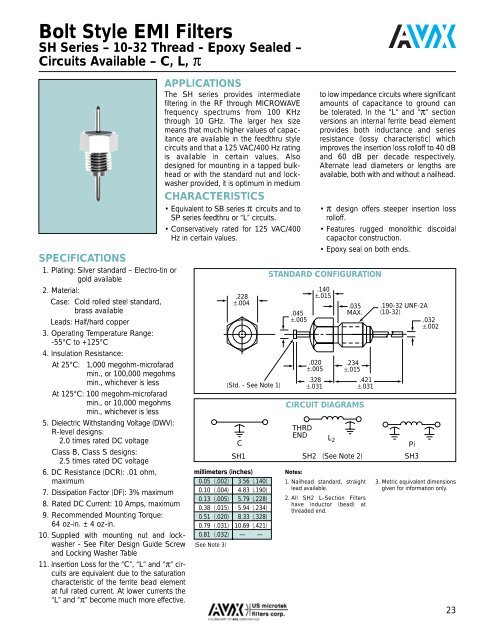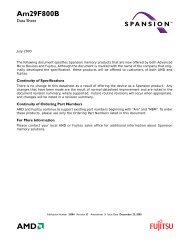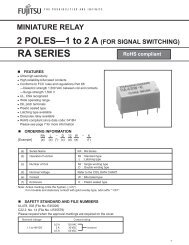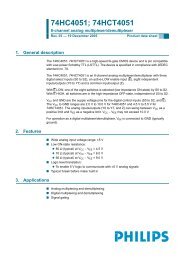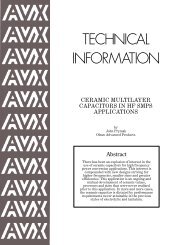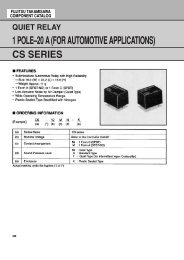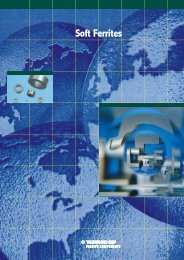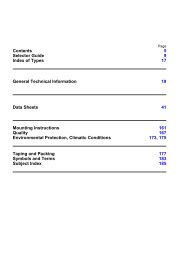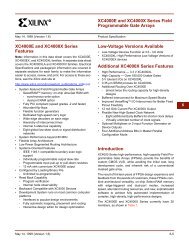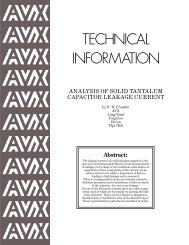AVX US Microtek EMI Filters Catalog - RYSTON Electronics sro
AVX US Microtek EMI Filters Catalog - RYSTON Electronics sro
AVX US Microtek EMI Filters Catalog - RYSTON Electronics sro
Create successful ePaper yourself
Turn your PDF publications into a flip-book with our unique Google optimized e-Paper software.
Bolt Style <strong>EMI</strong> <strong>Filters</strong><br />
SH Series – 10-32 Thread - Epoxy Sealed –<br />
Circuits Available – C, L, π<br />
SPECIFICATIONS<br />
1. Plating: Silver standard – Electro-tin or<br />
gold available<br />
2. Material:<br />
Case: Cold rolled steel standard,<br />
brass available<br />
Leads: Half/hard copper<br />
3. Operating Temperature Range:<br />
-55°C to +125°C<br />
4. Insulation Resistance:<br />
At 25°C: 1,000 megohm-microfarad<br />
min., or 100,000 megohms<br />
min., whichever is less<br />
At 125°C: 100 megohm-microfarad<br />
min., or 10,000 megohms<br />
min., whichever is less<br />
5. Dielectric Withstanding Voltage (DWV):<br />
R-level designs:<br />
2.0 times rated DC voltage<br />
Class B, Class S designs:<br />
2.5 times rated DC voltage<br />
6. DC Resistance (DCR): .01 ohm,<br />
maximum<br />
7. Dissipation Factor (DF): 3% maximum<br />
8. Rated DC Current: 10 Amps, maximum<br />
9. Recommended Mounting Torque:<br />
64 oz-in. ± 4 oz-in.<br />
10. Supplied with mounting nut and lockwasher<br />
- See Filter Design Guide Screw<br />
and Locking Washer Table<br />
11. Insertion Loss for the “C”, “L” and “π” circuits<br />
are equivalent due to the saturation<br />
characteristic of the ferrite bead element<br />
at full rated current. At lower currents the<br />
“L” and “π” become much more effective.<br />
APPLICATIONS<br />
The SH series provides intermediate<br />
filtering in the RF through MICROWAVE<br />
frequency spectrums from 100 KHz<br />
through 10 GHz. The larger hex size<br />
means that much higher values of capacitance<br />
are available in the feedthru style<br />
circuits and that a 125 VAC/400 Hz rating<br />
is available in certain values. Also<br />
designed for mounting in a tapped bulkhead<br />
or with the standard nut and lockwasher<br />
provided, it is optimum in medium<br />
CHARACTERISTICS<br />
• Equivalent to SB series π circuits and to<br />
SP series feedthru or “L” circuits.<br />
• Conservatively rated for 125 VAC/400<br />
Hz in certain values.<br />
.228<br />
±.004<br />
(Std. - See Note 1)<br />
millimeters (inches)<br />
0.05 (.002) 3.56 (.140)<br />
0.10 (.004) 4.83 (.190)<br />
0.13 (.005) 5.79 (.228)<br />
0.38 (.015) 5.94 (.234)<br />
0.51 (.020) 8.33 (.328)<br />
0.79 (.031) 10.69 (.421)<br />
0.81 (.032) — —<br />
(See Note 3)<br />
C<br />
SH1<br />
.045<br />
±.005<br />
.020<br />
±.005<br />
to low impedance circuits where significant<br />
amounts of capacitance to ground can<br />
be tolerated. In the “L” and “π” section<br />
versions an internal ferrite bead element<br />
provides both inductance and series<br />
resistance (lossy characteristic) which<br />
improves the insertion loss rolloff to 40 dB<br />
and 60 dB per decade respectively.<br />
Alternate lead diameters or lengths are<br />
available, both with and without a nailhead.<br />
• π design offers steeper insertion loss<br />
rolloff.<br />
• Features rugged monolithic discoidal<br />
capacitor construction.<br />
• Epoxy seal on both ends.<br />
STANDARD CONFIGURATION<br />
.140<br />
±.015<br />
.328<br />
±.031<br />
.035<br />
MAX.<br />
.234<br />
±.015<br />
.421<br />
±.031<br />
CIRCUIT DIAGRAMS<br />
THRD<br />
END L 2<br />
SH2 (See Note 2)<br />
Notes:<br />
1. Nailhead standard, straight<br />
lead available.<br />
2. All SH2 L-Section <strong>Filters</strong><br />
have inductor (bead) at<br />
threaded end.<br />
.190-32 UNF-2A<br />
(10-32)<br />
.032<br />
±.002<br />
Pi<br />
SH3<br />
3. Metric equivalent dimensions<br />
given for information only.<br />
23


